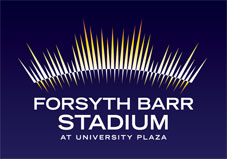'Glass House'[1] | |
 | |
 View of the stadium from the south-east | |
 | |
| Full name | Forsyth Barry Stadium |
|---|---|
| Former names |
|
| Location | Anzac Avenue, Logan Park, Dunedin, Otago, New Zealand |
| Coordinates | 45°52′9″S 170°31′28″E / 45.86917°S 170.52444°E |
| Owner | Dunedin City Council |
| Operator | Dunedin Venues Management Ltd |
| Capacity | 30,748 (Rugby/Football) 36,000 (Concerts) 15,000 (Rodeo) |
| Surface | Desso GrassMaster |
| Construction | |
| Broke ground | May 2009 |
| Built | 2009-2011 |
| Opened | 5 August 2011 |
| Construction cost | NZ$ 198.3 million |
| Architect | Jasmax Populous |
| Tenants | |
| Otago (2011–) Highlanders (2012–) Southern United FC (2011–) | |


Forsyth Barr Stadium is a multi-purpose stadium in Dunedin, New Zealand.[2][3][4] At various stages of development it was also known as Dunedin Stadium or Awatea Street Stadium,[5] or its non-commercial official name during the 2011 Rugby World Cup and 2015 FIFA U-20 World Cup, Otago Stadium.[6] The fully covered stadium is also known colloquially as 'The Glasshouse' due to its resemblance to a horticultural hothouse.[7]
The stadium was opened by New Zealand Prime Minister John Key on 5 August 2011, replacing Carisbrook as the home stadium of the Highlanders team in Super Rugby and the Otago Rugby Football Union team in the domestic Mitre 10 Cup. The stadium hosted four matches of the 2011 Rugby World Cup, and has hosted major music tours, starting in November 2011 with Elton John. The venue hosted multiple matches for the 2023 FIFA Women's World Cup.
- ^ "FORSYTH BARR STADIUM". www.espnscrum.com. Retrieved 19 March 2015.
- ^ "Home". Forsyth Barr Stadium. Retrieved 18 October 2024.
- ^ Price, Mark (30 January 2009). "Dunedin company Forsyth Barr puts name to stadium". Otago Daily Times. Retrieved 29 January 2009.
- ^ Craymer, Lucy (30 January 2009). "Forsyth Barr ignores recession to buy Otago stadium naming rights". National Business Review. Archived from the original on 3 March 2016. Retrieved 29 January 2009.
- ^ "New stadium pivotal to Dunedin and Otago's future | Otago Regional Council". Archived from the original on 17 April 2017. Retrieved 3 June 2015.
- ^ "Stadium nears completion". Otago Daily Times. 11 June 2011. Retrieved 30 September 2011.
- ^ "Forsyth Barr Stadium". British & Irish Lions. Retrieved 17 January 2021.